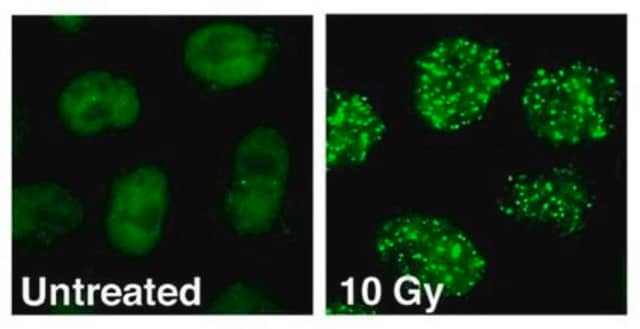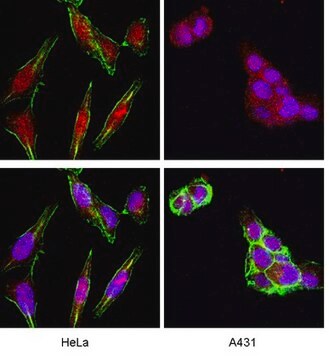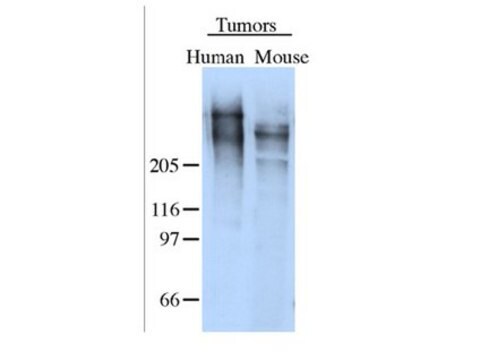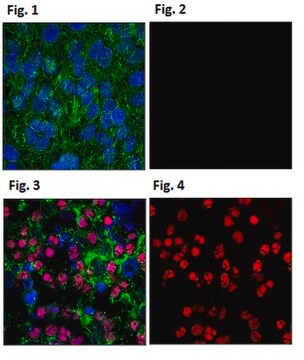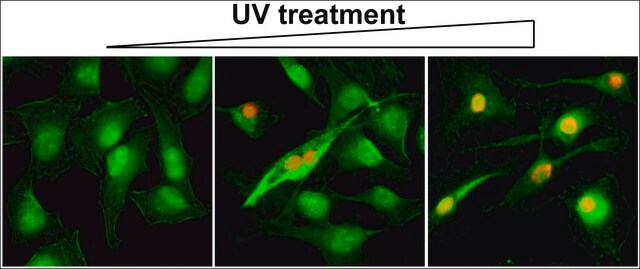05-740
Anti-phospho-ATM (Ser1981) Antibody, clone 10H11.E12
clone 10H11.E12, Upstate®, from mouse
Sinonimo/i:
A-T, mutated, AT mutated, TEL1, telomere maintenance 1, homolog, ataxia telangiectasia mutated, ataxia telangiectasia mutated (includes complementation groups A, C and D), ataxia telangiectasia mutated protein, human phosphatidylinositol 3-kinase homolog
About This Item
Prodotti consigliati
Origine biologica
mouse
Livello qualitativo
Forma dell’anticorpo
purified antibody
Tipo di anticorpo
primary antibodies
Clone
10H11.E12, monoclonal
Reattività contro le specie
mouse, human
Confezionamento
antibody small pack of 25 μg
Produttore/marchio commerciale
Upstate®
tecniche
immunocytochemistry: suitable
immunofluorescence: suitable
immunoprecipitation (IP): suitable
western blot: suitable
Isotipo
IgG1κ
N° accesso NCBI
N° accesso UniProt
Condizioni di spedizione
ambient
modifica post-traduzionali bersaglio
phosphorylation (pSer1981)
Informazioni sul gene
human ... ATM(472)
Descrizione generale
Specificità
Immunogeno
Applicazioni
Phosphorylated ATM was immunoprecipitated from irradiated HeLa cells (Figure A, lanes 3 and 4).
Immunocytochemistry:
Foci are detected in irradiated human and mouse fibroblasts. Determined by an independent laboratory.
Epigenetics & Nuclear Function
Cell Cycle, DNA Replication & Repair
Qualità
Western Blot Analysis:
0.5 µg/mL of this lot detected phosphorylated ATM in crude lysates from irradiated HeLa cells.
Descrizione del bersaglio
Stato fisico
Stoccaggio e stabilità
Handling Recommendations:
Upon receipt, and prior to removing the cap, centrifuge the vial and gently mix the solution. Aliquot into microcentrifuge tubes and store at -20°C. Avoid repeated freeze/thaw cycles, which may damage IgG and affect product performance. Note: Variability in freezer temperatures below -20°C may cause glycerol containing solutions to become frozen during storage.
Risultati analitici
Irradiated HeLa cell lysates
Altre note
Note legali
Esclusione di responsabilità
Non trovi il prodotto giusto?
Prova il nostro Motore di ricerca dei prodotti.
Raccomandato
Codice della classe di stoccaggio
10 - Combustible liquids
Classe di pericolosità dell'acqua (WGK)
WGK 1
Certificati d'analisi (COA)
Cerca il Certificati d'analisi (COA) digitando il numero di lotto/batch corrispondente. I numeri di lotto o di batch sono stampati sull'etichetta dei prodotti dopo la parola ‘Lotto’ o ‘Batch’.
Possiedi già questo prodotto?
I documenti relativi ai prodotti acquistati recentemente sono disponibili nell’Archivio dei documenti.
Il team dei nostri ricercatori vanta grande esperienza in tutte le aree della ricerca quali Life Science, scienza dei materiali, sintesi chimica, cromatografia, discipline analitiche, ecc..
Contatta l'Assistenza Tecnica.

